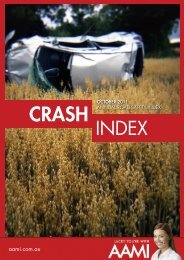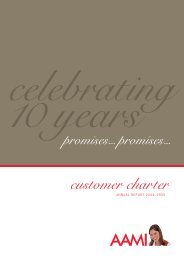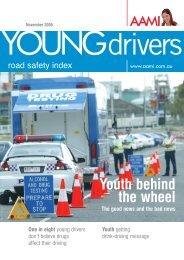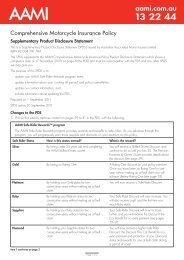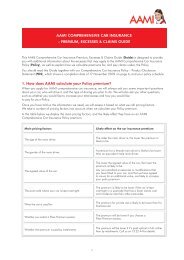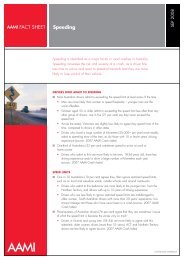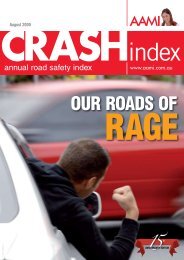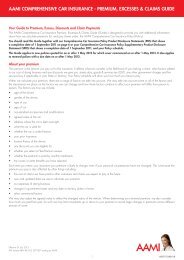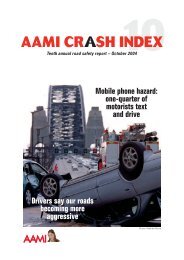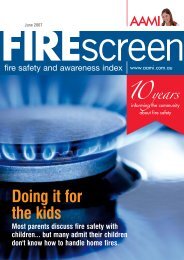AAMI Home Security Index 2005
AAMI Home Security Index 2005
AAMI Home Security Index 2005
- TAGS
- aami
- home
- security
- index
- www.aami.com.au
Create successful ePaper yourself
Turn your PDF publications into a flip-book with our unique Google optimized e-Paper software.
March <strong>2005</strong><br />
SECURITY<br />
home security index<br />
www.aami.com.au<br />
One in ten Australians<br />
has experienced<br />
home intrusion<br />
One in five people don’t<br />
warn their neighbours after<br />
experiencing a burglary
This is the eighth annual <strong>AAMI</strong> <strong>Home</strong> <strong>Security</strong> <strong>Index</strong>, • Adelaide/regional • Coffs Harbour & • North Queensland<br />
formerly published as the <strong>AAMI</strong> Car and <strong>Home</strong> <strong>Security</strong> South Australia Port Macquarie • Sunshine Coast<br />
<strong>Index</strong>. It is published to inform and educate the community • Ballarat, Bendigo & • Dubbo • Sydney<br />
about trends in home crime and security. The <strong>Index</strong> is Shepparton • Geelong • Toowoomba/<br />
based on data collected from two sources: an independent • Batemans Bay, • Gold Coast Darling Downs<br />
survey of more than 2400 Australian adults and an in-depth Bega & Ulladulla • Hobart • Wagga Wagga &<br />
analysis of insurance claims lodged in 2004 by <strong>AAMI</strong> • Brisbane • Launceston<br />
Griffith<br />
policyholders in the Australian Capital Territory, New South<br />
Wales, Queensland, South Australia, Tasmania and Victoria..<br />
The survey was conducted in the following areas:<br />
• Canberra<br />
• Central Queensland<br />
• Melbourne<br />
• Newcastle & Gosford<br />
• Woollongong<br />
& Nowra<br />
Intruders become<br />
more brazen<br />
One in ten Australians (11 per cent),<br />
has personal experience of home<br />
intrusion – where a thief has broken in<br />
while they were at home.<br />
Of the people who experienced home<br />
intrusion, half (49 per cent) became<br />
aware that the intruder was on the<br />
property. Of those who became aware of<br />
the intruder, 68 per cent confronted<br />
them, and in one-quarter of these<br />
situations (24 per cent), violence ensued.<br />
Common times for theft<br />
According to <strong>AAMI</strong>’s claims statistics for<br />
2004, burglaries were most common on<br />
Fridays (more than 16 per cent) between<br />
the hours of 8 am and 12 pm. The most<br />
common month for burglary was<br />
December, where more than 11 per cent<br />
of all claims were reported.<br />
Burglary a common experience<br />
Many Australians (38 per cent) have<br />
experienced a burglary at some point<br />
in their lives.<br />
People who live in metropolitan areas<br />
were far more likely to experience a<br />
burglary than people in regional areas<br />
(43 per cent compared with 29 per<br />
cent in regional areas).<br />
One in 20 people (5 per cent) who<br />
have a garden shed have had it broken<br />
into. This crime occurred most often in<br />
South Australia, where ten per cent of<br />
people said their shed had been broken<br />
ACCORDING TO<br />
<strong>AAMI</strong>’S CLAIMS<br />
STATISTICS<br />
FOR 2004,<br />
BURGLARIES<br />
WERE MOST<br />
COMMON ON<br />
FRIDAYS.<br />
into. Nationally, of those who have garden<br />
shed, half (52 per cent) admit it is not as<br />
secure as it should be.<br />
Neighbours not warned of crime<br />
One in five people (21 per cent) did not<br />
warn their neighbours that a thief was at<br />
work in the area after the burglary<br />
occurred. People in New South Wales<br />
were most likely to warn their neighbours<br />
(88 per cent did so) and Victorians were<br />
least likely (69 per cent).<br />
<strong>Home</strong>owners were more likely to warn<br />
neighbours after a break-in than renters<br />
(83 per cent did compared with 63 per<br />
cent). The likelihood of communicating<br />
with neighbours about theft increased<br />
with age – 62 per cent of 18-34-year-olds<br />
KEY FINDINGS<br />
did so, compared with 83 per cent of<br />
those aged 35 and older.<br />
Some forget basic security<br />
Despite the knowledge that most theft<br />
is opportunistic, some people still forget<br />
to attend to basic security around<br />
their homes.<br />
One-third of Australians (36 per cent)<br />
admitted they had been known to leave<br />
their front or back door open when they<br />
probably should not. This was least<br />
common in Victoria (31 per cent) and the<br />
Australian Capital Territory (25 per cent).<br />
Most of those who had no security<br />
features at all in the home, such as<br />
deadlocks, window locks or alarms, left<br />
their doors open (59 per cent).<br />
■ Four in ten Australians (38 per cent) has experienced a break-in at some<br />
point in their lives.<br />
■ One in ten Australians (11 per cent) has been burgled while someone<br />
was at home.<br />
■ Almost half of Australians (44 per cent) do not investigate or call the<br />
police when they hear a home alarm. 1<br />
■ One in seven Australians (14 per cent) say they have no home or<br />
contents-related insurance to protect their home and possessions.<br />
■ One in ten people (10 per cent) do not have any security at all in their<br />
home, such as deadlocks, window locks, alarms, security grills or safes.<br />
■ One in 20 Australians (5 per cent) do not take any security measures to<br />
protect their home when they go on holiday. 2<br />
■ One in five people (21 per cent) don’t warn their neighbours about thieves<br />
in the area after they’ve been burgled.
One-third of people with deadlocks<br />
(34 per cent) said these locks were not<br />
always activated when they should be. A<br />
similar proportion of those with window<br />
locks (38 per cent) said their locks were<br />
not always activated when they should<br />
be. People who have experienced a<br />
burglary at their current home were more<br />
likely to be vigilant with home security –<br />
27 per cent who have experienced a<br />
burglary at their current home said their<br />
locks are not always used compared with<br />
41 per cent who had not experienced a<br />
burglary at their current home.<br />
Four in ten people with home alarms (42<br />
per cent) said they sometimes go out<br />
without turning on their alarm. This<br />
number was lower among people who<br />
had experienced a burglary at their<br />
current home – of them, one-third (33<br />
per cent) said they sometimes go out<br />
without turning the alarm on.<br />
Alarms ignored<br />
Almost half of Australians (44 per cent)<br />
said they do not investigate or call the<br />
police when they hear a home alarm.<br />
Just 21 per cent of people believed an<br />
alarm was the most effective security<br />
measure to protect their home when they<br />
go away on holidays.<br />
Holiday anxiety<br />
One-third of Australians (35 per cent) are<br />
apprehensive about going on holidays in<br />
case they are burgled while they are<br />
away. Not surprisingly, people who have<br />
been burgled at their current address are<br />
more likely to say they are anxious about<br />
13.96 15.46 11.98 19.41 13.45 11.37 18.93<br />
National<br />
<strong>Home</strong> burglaries per 1000 policies – 2004<br />
Queensland NSW ACT Victoria Tasmania South<br />
Australia<br />
Source: <strong>AAMI</strong> Claims data 2004 (no statistics available for Northern Territory)<br />
a break-in when they go on holidays<br />
compared with those who have not<br />
(44 per cent compared with 34 per cent).<br />
Most Australians (95 per cent) take some<br />
kind of security precaution when leaving<br />
their home for an extended period of time.<br />
Most people (85 per cent) ask a friend or<br />
neighbour to keep an eye on their home or<br />
collect their mail. Four in ten (41 per cent)<br />
leave a light on in the house and one-third<br />
(33 per cent) leave devices on timers,<br />
such as a sprinkler or lights. A similar<br />
proportion (35 per cent) tries to arrange a<br />
house sitter. Three in ten people (28 per<br />
cent) activate an alarm system.<br />
When asked which of the above measures<br />
were most effective, generally, people felt<br />
that a human presence was the best<br />
deterrent to thieves. One-third (35 per<br />
cent) felt that asking someone to keep an<br />
eye on their home or collect their mail was<br />
the most effective deterrent to being<br />
burgled. As popular was arranging a<br />
house sitter (34 per cent).<br />
Securing our homes<br />
One in ten Australians (10 per cent) has no<br />
security features in their home at all. Many<br />
people, however, had more than one<br />
security feature. Seven in ten (71 per cent)<br />
had deadlocked external doors, 64 per<br />
cent had window locks and 29 per cent<br />
had an alarm system. People in regional<br />
areas were twice as likely not to have any<br />
security in their home when compared<br />
with those in metropolitan areas.<br />
Incentives for extra security<br />
One in seven people (15 per cent) have<br />
NINE IN TEN<br />
PEOPLE (88 PER<br />
CENT) BELIEVE A<br />
BARKING DOG IS<br />
GOOD DETERRENT<br />
TO THIEVES.<br />
How thieves get in<br />
invested in more sophisticated security<br />
measures such as video surveillance,<br />
card access or security patrols.<br />
Tasmanians were least likely to have this<br />
extra security (8 per cent) and people in<br />
New South Wales were most likely (18<br />
per cent). Newer homes were also more<br />
likely to have these features – 24 per<br />
cent of homes aged less than 10 years<br />
had these and just 11 per cent of homes<br />
aged 21 years or more had them.<br />
Just over half (52 per cent) of people<br />
who do not have any of these<br />
sophisticated security measures would<br />
consider at least one of them if they<br />
received a discount on their insurance<br />
as a result.<br />
Two in ten not insured<br />
against theft<br />
Eight in ten (81 per cent) Australians<br />
reported that they had contents<br />
insurance in case of theft from their<br />
home. <strong>Home</strong>owners are far more likely<br />
to have home insurance – 92 per cent of<br />
home owners said they had home<br />
insurance compared with just 52 per<br />
cent of renters.<br />
Fourteen per cent of Australians has no<br />
insurance for their belongings.<br />
Many keep records<br />
of belongings<br />
Most people had at least one measure in<br />
place to assist them in making an<br />
insurance claim if their home was burgled.<br />
Half (47 per cent) had a list of<br />
possessions and their approximate value.<br />
Window 26%<br />
Door 39%<br />
No sign of entry 12%<br />
Garage Door 22%<br />
Other 1%
v<br />
The impact of home intrusion on victims<br />
<strong>Home</strong> intrusions receive a lot of Being a victim of crime affects bedroom, and this can become a<br />
media attention. Fortunately, they people in different ways. While long-term problem.<br />
are not common, but when they<br />
do take place they can leave a<br />
every person’s reaction to crime is<br />
unique, it is not unusual for people<br />
The financial burden of home<br />
intrusion extends beyond the<br />
victim feeling devastated and who have experienced a home loss and damage to property.<br />
violated. The crime can destroy a intrusion to feel shocked, fearful, Victims sometimes need<br />
person’s trust in others and angry, depressed or anxious. therapeutic treatment,<br />
blacken their view of the local Some victims may experience counselling, and in extreme<br />
community and society in difficulty sleeping; nightmares; cases, pharmacological<br />
general. <strong>Home</strong> intrusions fracture obtrusive mental flashbacks; intervention. Some may be<br />
the sanctity of the home on a emotional withdrawal and unable to work for a period.<br />
deep level, causing victims to feel<br />
unsafe and constantly aware of<br />
danger in their own environment.<br />
In many cases, occupants are left<br />
with a deep-seated fear that the<br />
offender will return.<br />
coldness; relationship difficulties;<br />
and anger management problems.<br />
Some victims report being<br />
alarmed by any small sound or<br />
vibration in their home.<br />
Children are particularly<br />
While the reactions described<br />
above are a natural and normal<br />
part of the process of dealing with<br />
a traumatic event, in most cases<br />
they are temporary. With support<br />
from family, friends and<br />
Victims of home intrusion often susceptible to the psychological colleagues, most people recover<br />
describe the trauma of being effects of home intrusion. Many from the effects of crime within a<br />
powerless, and feeling vulnerable children develop a phobia of being few months. For other people, the<br />
and frightened that they will be in a room alone. Children who recovery process is more difficult.<br />
injured or killed. For some, the were previously confident and Prepared by the Victims Support<br />
worst aspect is the uncertainty outgoing can become insecure Agency, part of the Victorian<br />
of the crime — not knowing how and clingy. Some children are only State Government’s Department<br />
far the offender will go. able to sleep in their parents’ of Justice.<br />
TEN TIPS FOR SECURING YOUR HOME AND BELONGINGS<br />
1. Remember the basics – it’s no good installing 6. Don’t leave doors or windows wide open for<br />
locks and then not using them. long periods even while you’re at home.<br />
2. Make sure everyone in your home is equally 7. Don’t leave car keys and wallets beside open<br />
security conscious. Have a routine that windows or doors.<br />
everyone follows to check locks and switch on 8. Engage deadlocks when you leave the house<br />
alarms when the house is left unoccupied. so that thieves cannot carry items out through<br />
3. Tell your neighbours if your home is broken into your main doors.<br />
– then they can remember to be extra careful 9. If you can’t arrange for someone to pick up<br />
and report any suspicious people to police. your mail every day when you’re on holiday,<br />
4. Don’t assume balcony doors or high windows ask the post office to hold it until you return.<br />
are safe to leave unlocked – thieves are good Also, attach a ‘no advertising material’ sign to<br />
at finding ways to overcome these obstacles. your letterbox so it doesn’t overflow.<br />
5. Pack easy-to-carry, expensive items such as 10. Lock up your meter box to prevent thieves<br />
laptops, iPods and jewellery away and out of tampering with your power supply.<br />
sight so thieves can’t see them.<br />
The <strong>AAMI</strong> <strong>Home</strong> <strong>Security</strong> <strong>Index</strong> is prepared with the<br />
help of a nationally recognised independent research<br />
company Sweeney Research, which ensures the<br />
validity of the survey methodology and findings. The<br />
study is based upon a national telephone survey<br />
conducted in <strong>2005</strong> using a representative and<br />
statistically valid sample* of 2400 Australian adults in<br />
major population centres and regions across Australia.<br />
Except where stated, the survey explores respondents’<br />
experiences of home burglaries over their lifetime.<br />
<strong>AAMI</strong>’s research may differ from government and<br />
police sources, which typically examine a 12-month<br />
VICTIMS OF CRIME<br />
SUPPORT SERVICES<br />
A person does not have to<br />
suffer a physical injury to be<br />
a victim of crime. Injuries can<br />
also be psychological and<br />
emotional.<br />
Support services are<br />
available to victims in each<br />
state and territory, offering<br />
both emotional support and<br />
practical advice about the<br />
Justice system.<br />
Some victims may benefit<br />
from counselling to help them<br />
through the recovery process<br />
and staff can assist victims in<br />
contacting the most<br />
appropriate support agency<br />
to meet their needs.<br />
New South Wales<br />
Victims Support Line<br />
1800 633063<br />
Victoria<br />
Victims of Crime Helpline<br />
1800 819817<br />
Queensland<br />
Victims Counselling and<br />
Support Service<br />
1300 139703<br />
South Australia<br />
Victim Support Service<br />
1800 182368<br />
Tasmania<br />
Victims of Crime Support<br />
1300 300238<br />
ACT<br />
Victim Services Scheme<br />
1800 822 272<br />
Western Australia<br />
Victim Support Service<br />
08 9425 2850<br />
Northern Territory<br />
Victims of Crime NT<br />
(previously VOCAL)<br />
1800 672242<br />
period. Also, smaller or unreported incidents may be<br />
captured in <strong>AAMI</strong>’s research and not by others.<br />
*The confidence interval for this sample size is plus or minus<br />
2 percent, which means that for the survey sample of 2400,<br />
if the observed percentage result is 50 per cent, the chances<br />
are 95 in 100 that the range – 48-52 per cent – includes the<br />
true percentage for the total Australian population.<br />
PRINTED ON RECYCLED PAPER PO111P035




